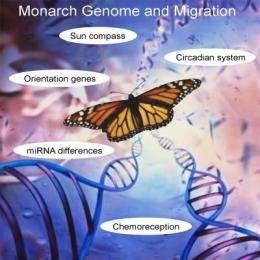Draft sequence of monarch butterfly genome presented

Each fall millions of monarch butterflies from across the eastern United States use a time-compensated sun compass to direct their navigation south, traveling up to 2,000 miles to an overwintering site in a specific grove of fir trees in central Mexico. Scientists have long been fascinated by the biological mechanisms that allow successive generations of these delicate creatures to transverse such long distances to a small region roughly 300 square miles in size. To unlock the genetic and regulatory elements important for this remarkable journey, neurobiologists at the University of Massachusetts Medical School (UMMS) are the first to sequence and analyze the monarch butterfly genome.
"Migratory monarchs are at least two generations removed from those that made the journey the previous fall," said Steven M. Reppert, MD, professor and chair of neurobiology and senior author of the study. "They have never been to the overwintering sites before, and have no relatives to follow on their way. There must be a genetic program underlying the butterflies' migratory behavior. We want to know what that program is, and how it works."
In a paper published in the journal Cell, Reppert and UMMS colleagues Shuai Zhan, PhD, and Christine Merlin, PhD, along with collaborator Jeffrey L. Boore, PhD, CEO of Genome Project Solutions, describe how next-generation sequencing technology was used to generate a draft 273 Mb genome of the migratory monarch. Analysis of the combined genetic assembly revealed an estimated set of 16,866 protein-coding genes, comprising several gene families likely involved in major aspects of the monarch's seasonal migration. The novel insights observed by Reppert and colleagues in the newly sequenced monarch genome include:
- identifying genes involved in visual input and central processing by the sun compass
- a full repertoire of molecular components for the monarch circadian clock
- all members of the juvenile hormone biosynthetic pathway whose regulation is critical for a successful migration and which shows an unexpected regulation pattern
- additional molecular signatures of oriented flight behavior
- monarch-specific expansions of odorant receptors potentially important for long-distance migration
- a variant of the sodium/potassium pump that underlies a valuable chemical defense mechanism to fend off predators during the migration
Understanding the relationship between genes, behavior and physiological adaptations in monarchs may also lead to new insights into similar connections in humans. Circadian clocks, for instance, are a crucial component in the complex time-compensated sun compass system governing a monarch's ability to navigate long distances and are now understood to play a pivotal role in human biology. Temporal variations in hormone levels, pharmacokinetics, and disease processes, such as the increased incidence of heart attacks in the early morning, reveal the prominent influence of the circadian clock on human physiology. Understanding the molecular mechanisms of the circadian clock has already helped reveal how clock gene mutations contribute to disorders of the timing of sleep, and new insights into these genetic processes could illuminate how clock gene mutations contribute to diseases like major depression and seasonal affective disorder.
"In terms of fundamental brain processes, those involved in the navigation mechanisms used for long-distance migration have been difficult to decipher," said Reppert. "Dissecting the genetic basis of long-distance migration in the monarch may help us understand these mechanisms not only in monarchs but more generally in other migrants, including migratory birds and sea turtles."
Provided by University of Massachusetts Medical School















